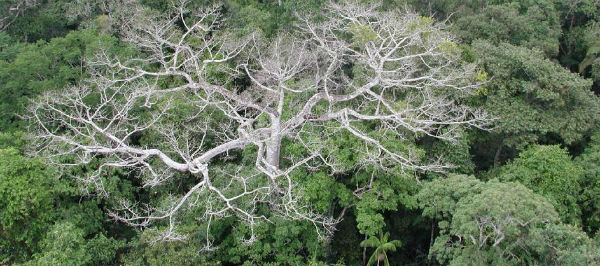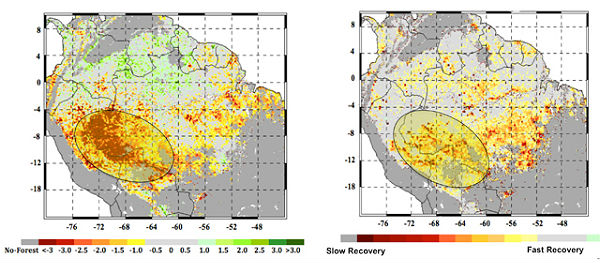Long-term effects of megadrought on Amazonian forests

The rainforests in southern and western Amazonia may be showing the first signs of potential large-scale degradation due to climate change as Amazon rainforest continues to suffer from the effects of a megadrought that began in 2005, attributed to the long-term warming of tropical Atlantic sea surface temperatures.
During the summer of 2005, more than 700,000 square kilometers or 70 million hectares (270,000 square miles) of old-growth forest in southwestern Amazonia experienced an extensive, severe drought which caused widespread changes to the forest canopy that were detectable by satellite. The changes suggest dieback of branches and tree falls, especially among the older, larger, more vulnerable canopy trees that blanket the forest.
An international research team led by Sassan Saatchi of NASA’s Jet Propulsion Laboratory, analyzed more than a decade of satellite microwave radar data collected between 2000 and 2009 over Amazonia. The observations included measurements of rainfall from NASA’s Tropical Rainfall Measuring Mission (TRMM) and measurements of the moisture content and structure of the forest canopy from the Seawinds scatterometer on NASA’s QuikScat spacecraft. Results of the study were published recently in the Proceedings of the National Academy of Sciences.
Scientists had expected the forest canopy to bounce back after a year with a new flush of leaf growth, but the damage appeared to persist right up to the subsequent drought in 2010. About half the forest affected by the 2005 drought – an area the size of California – did not recover by the time QuikScat stopped gathering global data in November 2009. Until now, there had been no satellite-based assessment of the multi-year impacts of these droughts across all of Amazonia.
 At left, the extent of the 2005 megadrought in the western Amazon rainforests during the summer months of June, July and August as measured by NASA satellites. The most impacted areas are shown in shades of red and yellow. The circled area in the right panel shows the extent of the forests that experienced slow recovery from the 2005 drought, with areas in red and yellow shades experiencing the slowest recovery. (Credit: NASA/JPL-Caltech/GSFC)
At left, the extent of the 2005 megadrought in the western Amazon rainforests during the summer months of June, July and August as measured by NASA satellites. The most impacted areas are shown in shades of red and yellow. The circled area in the right panel shows the extent of the forests that experienced slow recovery from the 2005 drought, with areas in red and yellow shades experiencing the slowest recovery. (Credit: NASA/JPL-Caltech/GSFC)
Satellite and ground data have shown an increase in wildfires during drought years and tree die-offs following severe droughts. Large-scale droughts can lead to sustained releases of carbon dioxide from decaying wood, affecting ecosystems and Earth’s carbon cycle.
Scientists revealed that the same climate phenomenon that helped form hurricanes Katrina and Rita along U.S. southern coasts in 2005 also likely caused the severe drought in southwest Amazonia, which subsequently damaged the Amazonian trees.
New results suggest that if droughts continue at five- to 10-year intervals or increase in frequency due to climate change, large areas of the Amazon forest are likely to be exposed to persistent effects of droughts and corresponding slow forest recovery, which may alter the structure and function of Amazonian rainforest ecosystems.
About 30% or 1.7 million square kilometers (656,370 square miles) of the Amazon basin’s total current forest area was affected, with more than five percent of the forest experiencing severe drought conditions. The 2010 drought affected nearly half of the entire Amazon forest, with nearly a fifth of it experiencing severe drought. More than 600,000 square kilometers (231,660 square miles> of the area affected by the 2005 drought were also affected by the 2010 drought. The area has also experienced several localized mini-droughts in recent years.
of the area affected by the 2005 drought were also affected by the 2010 drought. The area has also experienced several localized mini-droughts in recent years.
Observations from ground stations show that rainfall over the southern Amazon rainforest declined by almost 3.2% per year in the period from 1970 to 1998. Climate analyses for the period from 1995 to 2005 show a steady decline in water availability for plants in the region. Together, these data suggest a decade of moderate water stress led up to the 2005 drought, helping trigger the large-scale forest damage seen following the 2005 drought.
Sources: NASA/JPL, WINDS/JPL, PNAS
Featured image: The megadrought during the summer of 2005 caused widespread damage and die-offs to trees, as depicted in this photo taken in Western Amazonia in Brazil. (Credit: NASA/JPL-Caltech)

Commenting rules and guidelines
We value the thoughts and opinions of our readers and welcome healthy discussions on our website. In order to maintain a respectful and positive community, we ask that all commenters follow these rules.